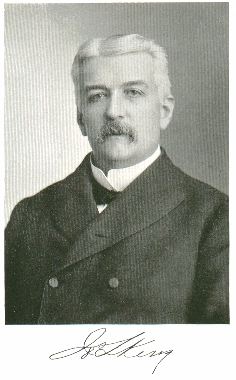
JOSEPH LIBBEY KING
Joseph Libbey King was born in Georgetown, D.C., on July 26, 1845. Mr.
King was the second son of a family of six children born to James King and
Charlotte Libbey King.
Surrounding the name of Mr. King’s father,
James King of William, is associated much of the romance, tradition and courage
that characterizes the efforts of the early pioneers of California to bring law
and order out of the then existing chaos of crime, and which efforts, largely
through the instrumentality of James King of William, eventually resulted in
the formation of the historical Vigilance Committee.
James King of William was one of the pioneer
bankers of San Francisco, his bank bearing his name as well as designation. He
was the founder of the San Francisco Bulletin, with the publication of which he
continued to be identified for a number of years. At the time of his death
James King of William was one of San Francisco's most influential and
outstanding citizens.
Joseph Libbey King, for a large part,
received his early education in the public schools of San Francisco, and
similar advantages were given to the other children of the family, all of the
sons of James King of William, Charles’s Joseph I., William Freeborn and
George, being now deceased, while the two daughters still reside in San
Francisco—Annie, the widow of Edward Dutton, and Josephine, widow of R.J.
Wilson.
As a young man Joseph Libbey King was for a
time employed in one of the pioneer banks of Virginia City, Nevada, and as this
was during the period of the nation-wide mining excitement of the Comstock
days, Mr. King became identified with this era of romantic mining activity and
at a place that was then the shrine of those who played and prayed for fame and
fortune.
When Mr. King returned to San Francisco he
became actively associated with the stock brokerage business, in which he for
many years continued to be a prominent and influential representative. Mr. King
was for a term of years allied with the brokerage firm of B.S. Sherwood &
Co., and was one of the best known and most popular members of the San
Francisco Stock Exchange, in which institution he held the position of caller
at the time of his death.
His Masonic affiliations included membership in the California Commandery
No. 1, Knights Templar, and Mr. King was also one of the active early members
of the well-known Bohemian Club.
To Mr. King belongs the distinction of being among the first to foresee
the magnitude of the oil industry as affecting the welfare of his state, and
was the first man to initiate and urge the establishment of an oil exchange. As
a citizen and as a business man, Mr. King was known for his wide vision and his
progressive ideas.
Mr. King was the author of the “The History
of the San Francisco Stock and Exchange Board,” an authoritative volume,
embracing not only extremely valuable statistical and other information of the
history of the institution as such, but in addition this volume shows Mr. Kings
as a kindly chronicler of the successes and failures, of the ambitions and the
hopes of that speculative epoch. Mr. King’s book teems with lights and shadows
and interesting personal reminiscences of considerable historical
importance.
With the passing of Mr. King, one of the few
remaining links between the gallant adventurers of the Comstock days and those
who have reaped the benefit of their foresight was served.
Mr. King was married to Miss Flora Ellen Mower, a native of Bangor,
Maine, on May 28, 1868. Mrs. King still resides in San Francisco. Of the five
children of this union, all native San Franciscans, the first born, James
William is deceased; Ralph Mower is engaged in farming in Lassen County and is
the father of two children, Lucie and Ralph P.; Percy Libbey is actively associated
with the California Packing Corporation; Joseph L., Jr., is with Hind-Rolph
& Co. of San Francisco, and Lucie is the wife of L.W. Harris of San
Francisco, her family consisting of three boys, Lawrence Junior, King and
Robert.
Louise E. Shoemaker, Transcriber February 13, 2004
Source: "The San
Francisco Bay Region" Vol. 3 page 70-72 by Bailey Millard. Published by The
American Historical Society, Inc. 1924.
© 2004 Louise Shoemaker